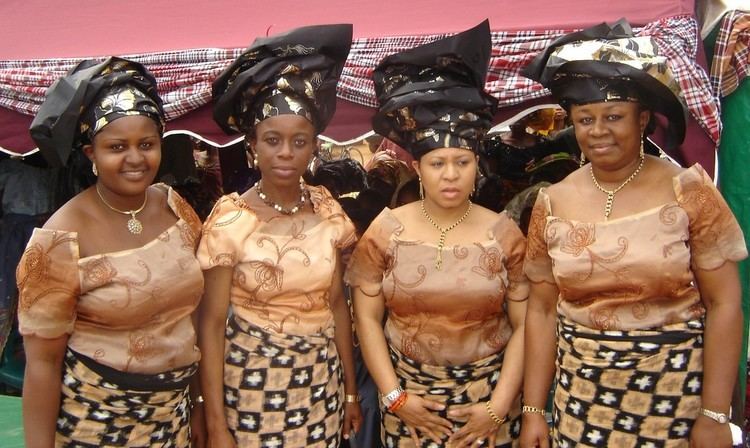 | ||
The wrapper, lappa, or pagne is a colorful women's garment widely worn in West Africa. It has formal and informal versions and varies from simple draped clothing to fully tailored ensembles. The formality of the wrapper depends on the fabric used to create it.
Contents
West African kaftan/boubou
In West Africa, a kaftan or caftan is a pull-over woman's robe. In French, this robe is called a boubou, pronounced boo-boo. The boubou is the traditional female attire in many West African countries including Senegal, Mali and other countries. The boubou can be formal or informal attire. The formality of the kaftan depends upon the fabric used to create it.
Yoruba iro
In Yorubaland, Nigeria the wrapper is common, called an iro in the Yoruba language, pronounced i-roh. The wrapper is usually worn with a matching headscarf or head tie that is called a gele in Yoruba, pronounced geh-leh. A full wrapper ensemble consists of three garments, a blouse, called a buba, pronounced boo-bah the iro and a headscarf called a head tie in English and a gele in Yoruba. Traditional male attire is called a agbada. A wrapper takes metres of quality fabric. White wrapper sets are worn during wedding ceremonies.
Pagne
Pagne designates a certain cut (two by six yards) and type (single-sided "Fancy" or double-sided "wax" prints) of untailored cotton textile, especially in Francophone West and Central Africa. Enormously popular in much of tropical Africa, the pagne cloth's usage and patterns may be used to by convey by the wearer a number of social, economic—and sometimes even political—messages. It is similar—though distinct in size, expected pattern, and usage—to the Khanga, Kikoy or Chitenge of East and Southern Africa. From the pagne any number of garments may be created (the boubou, dresses, or western style suits) or it can be used untailored as a wrap, headtie, skirt, or tied as a sling for children or goods. The word pagne, likely derived from the Latin pannum, was a term introduced by merchants from the 16th Century and adopted by several African societies to identify often pre-existing textiles or garments distinct from a simple cloth. The Portuguese pano for cloth has become the French pagne (loincloth), Dutch paan, and others. It appears to have originally referred to East Asian textiles traded in East and West Africa, before becoming a term for a certain length (a yard, later two by six yards) of commercial printed cloth sold in coastal West Africa.
In the West
In the UK and North America, a wrapper is also an older term for an informal house garment. Today, words such as housecoat and bathrobe (US) or dressing gown (UK) are usually employed instead.
Informal fabrics
Formal fabrics
Wedding attire
The kaftan is always worn with a headscarf or head tie. During a wedding ceremony, the bride's kaftan is the same color as the groom's dashiki. The traditional color for West African weddings is white. The most popular non-traditional color is purple or lavender, the color of African royalty. Blue, the color of love, is also a common non-traditional color. Most women wear black kaftans to funerals. However, in some parts of Ghana and the United States, some women wear black-and-white prints, or black and red. The kaftan is the most popular attire for women of African descent throughout the African diaspora. African and African-American women wear a wide variety of dresses, and skirt sets made out of formal fabrics as formal wear. However, the kaftan and wrapper are the two traditional choices. It is not uncommon for a woman to wear a white wedding dress when the groom wears African attire. In the United States, African-American women wear the boubou for special occasions. The kaftan or boubou is worn at weddings; funerals; graduations; and Kwanzaa celebrations.
The men's robe is also called a boubou, see Senegalese kaftan for further information.
Buba
A buba (pronounced boo-bah) is a woman's blouse. Buba is a Yoruba word that means blouse. The buba can be worn informally with pants or a fancy print wrapper. When worn as formal wear, the buba is paired with a skirt or wrapper made of formal fabrics. The informal dashiki, or men's shirt, is unisex and is also worn by women. The dashiki and buba differ in that the dashiki is boxy and baggy with a straight bottom, whereas the buba is fitted with a curved bottom, or baggy with a V shaped bottom. Like the dashiki, the buba comes in long, and short sleeve versions. The buba and skirt set or buba and wrapper set is the national costume of many West African countries.
